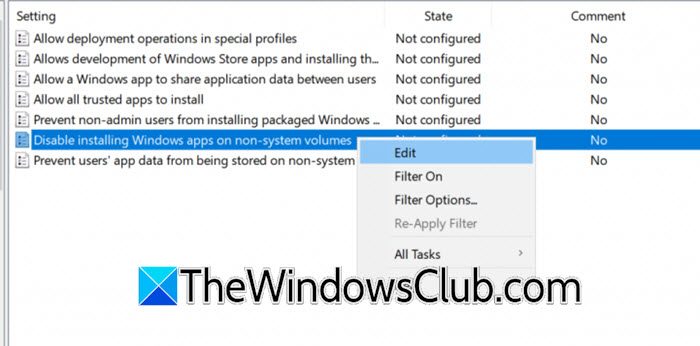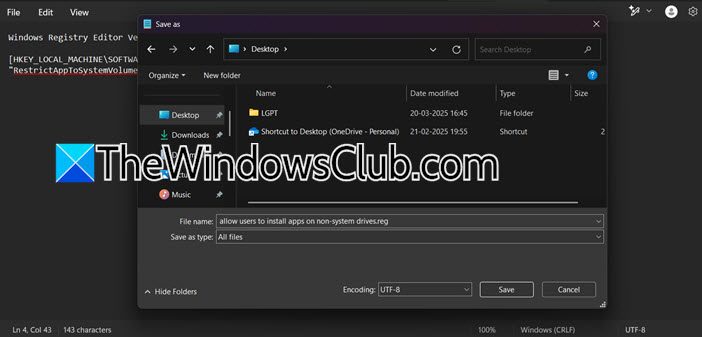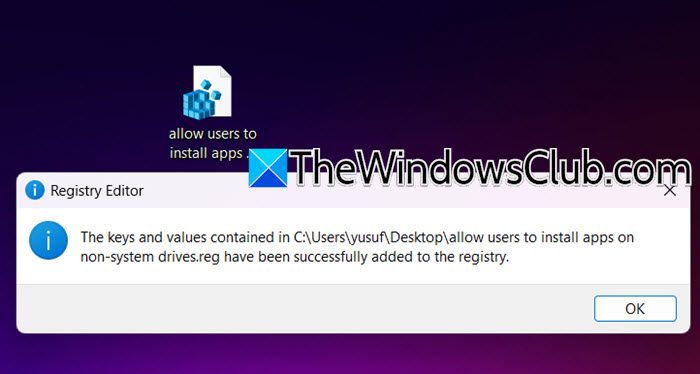Microsoft allows its users to install or move apps to other data drives that does not have the Windows operating system installed on them. Even though this is a feature, if you are setting up an organization, you may want to disable installing Windows apps on non-system drives to maintain the privacy and integrity of the network. In this post, we are going to learn how you can enable or disable moving or installing Windows apps on non-system drives.
Disable installing Windows apps on non-system drives
If you want to disable installing Windows apps on non-system drives, you can use one of the methods mentioned below.
- Prevent the installation of Windows apps using Group Policy Editor
- Disable the installation of Windows apps using Registry Editor
Let us talk about them in detail.
1] Prevent the installation of Windows apps using Group Policy Editor

Group Policy Editor (gpedit.msc) allows administrators to configure and manage system settings and user policies. It’s primarily used to customize how the operating system and applications behave across a computer or network. In order to disable the installation of Windows apps on non-system drives, we can use this tool. Also, if you are an admin, with the help of Gpedit, you can deploy this feature for all the users in your network. To do so, open the Group Policy Editor and then go to the following location.
Computer Configuration > Administrative Templates > Windows Components > App Package Deployment
Once you go to the App Package Deployment directory, look for Disable installing Windows apps on non-system volumes policy, right-click on it, and select Edit.
In case you don’t want to allow users to install Windows apps on non-system volumes, you need to set it to Enabled and click on Apply > Ok.
However, if you want to allow users to install these apps on non-system volumes, you can set it to Not-Configured or Disabled and then click on Apply > OK.
Read: How to move Program files from SSD to HDD in Windows
2] Disable the installation of Windows apps using Registry Editor
The Registry Editor allows users to view, edit, and manage the hierarchical database of settings and configurations for the operating system and installed applications. Since the Group Policy Editor is not available on Windows Home editions, we can use the Registry Editor for the same.
However, before making any changes to Registry Editor, we need to create a backup of the same that can be used in case something goes wrong. To do so, open the Registry Editor, then go to File > Import, then navigate to the location where you want to keep them, and save the file. This can be imported to restore the registry.
Now, open Notepad and paste the following line of codes.

You need the following code if you don’t want to allow users to install apps on non-system drives.
Windows Registry Editor Version 5.00 [HKEY_LOCAL_MACHINE\SOFTWARE\Policies\Microsoft\Windows\Appx] "RestrictAppToSystemVolume"=dword:00000001
To allow users to install apps on non-system drives, you need the following code.
Windows Registry Editor Version 5.00 [HKEY_LOCAL_MACHINE\SOFTWARE\Policies\Microsoft\Windows\Appx] "RestrictAppToSystemVolume"=-
Make sure to create two different scripts for two separate tasks, and their extension should be .reg.

Finally, double-click on the file, and when the UAC prompt appears, click Yes.
This will change the configuration of your computer and allow or prohibit the installation of Windows apps on non-system drives.
Read: How to move installed Windows Apps to another Drive.
How do I turn off Windows Installer GPO?
To turn off the Windows Installer using Group Policy, open the Local Group Policy Editor by typing “gpedit.msc” in the Run dialog. Navigate to Computer Configuration > Administrative Templates > Windows Components > Windows Installer. Now, locate the policy named Turn off Windows Installer and double-click it. Select Enabled, then choose Always from the drop-down menu under “Disable Windows Installer.” Click OK to save the changes. This will block the installation of MSI-based programs. Restart your system to apply the policy. This method ensures that users cannot install or uninstall software using the Windows Installer service.
Also Read: The System Administrator has set policies to prevent this installation.
Leave a Reply